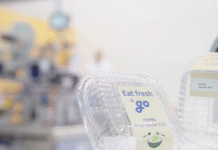
As the interest in food packaging safety grows across the world, so does the demand for package and label printing technology that protects packaged food from toxic substances. Responding to this trend and ever-stricter regulation, inkjet printer manufacturer Screen has teamed up with adhesives specialist Lintec to ensure the safety of low migration (low permeability) labels and adhesives for packaged food.
Screen Graphic Solutions, a subsidiary of Screen Holdings (Kyoto, Japan), is a manufacturer and supplier of system components for the prepress and printing industries. Its large range of equipment includes the Truepress Jet range of large format inkjet printers, UV inkjet label presses, sheet-fed and web-fed inkjet presses, the Equios workflow system, RIPs, and plate setters. The company is also a well-known manufacturer of equipment for the semiconductor and flat panel display manufacturing industries.
“We consider food packaging safety a responsibility of the entire supply chain. We therefore work with partners whenever possible to enhance the availability of safe and low migration packaging,” says Taishi Motoshige, manager sales, and operations at Screen Europe.
Building on decades of research and development of safe and efficient digital inkjet printing, Screen launched its new low migration label printer three years ago, the Truepress JetL350UV+ LM, which uses uniquely developed low migration inks that offer enhanced safety for food packaging applications. The printer is equipped with a nitrogen purge mechanism for accelerating the drying (also known as ‘curing’) of UV inks, further preventing ink migration. The Truepress JetL350UV+LM is popular in Europe, chosen by dozens of print companies. “Interest in our low migration label print technology remains strong, even in corona times,” says Motoshige.
Choice of adhesives
Although low-migration labels are crucial for food packaging safety, the choice of adhesives used to stick the labels to packaging is also essential.
Lintec, a label materials developer for packaging, has been investing in R&D for years to improve its ultra-low migration adhesives continually. Now, Screen and Lintec have partnered to ensure their technologies work smoothly together, producing food and pharmaceutical labels and packaging fast, efficiently, and following the highest regulatory standards.
“Safety issues related to the migration of ink and adhesive components throughout the food and pharmaceutical supply chain, as well as the potential health hazards that they could pose to end-users, are causes of concern for brand owners and manufacturers. Therefore, label and packaging suppliers face growing demand for solutions that ensure products are protected from contamination caused by inks and adhesives,” says Kazuya Katoh, general manager, Administration Department, R&D Division at Lintec.
Performance of combined low migration technologies
Screen and Lintec ran several independent third-party tests to assess the performance of their combined low migration technologies. According to the press statement, the test results revealed that, when Screen’s Truepress Jet L350UV+LM is combined with Lintec’s ultra-low migration labelstock, the overall migration limit (OML) is 0.6mg/100cm2. “This is an outstanding result, considering the current EU regulation allowance for OML is 10mg/100cm2,” says Motoshige.
By jointly tackling ink migration, “Lintec and Screen are showing their commitment to corporate responsibility and to delivering a product that provides brand owners and end-users the reassurance they need,” adds Katoh.
IndiFoodBev — authentic, impactful and influential
An English-language food and beverage processing and packaging industry B2B platform in print and web, IndiFoodBev is in its third year of publication. It is said that the Indian food and beverage industries represent approximately US$ 900 billion in revenues which implies more than 20% of the country’s GDP. Eliminating the wastage on the farmside can help to deliver more protein to a higher number of the population apart from generating sizable exports. The savings in soil, seeds, water, fertilizer, energy and ultimately food and nutrition could be the most immense contribution that country is poised to make to the moderation of climate change.
To improve your marketing and grow sales to the food and beverage processing and packaging industry, talk to us. Our research and consulting company IppStar [www.ippstar.org] can assess your potential and addressable markets in light of the competition. We can discuss marketing, communication, and sales strategies for market entry and growth.
Suppliers and service providers with a strategy and budget for targeted marketing can discuss using our hybrid print, web, video, and social media channels to create brand recognition linked to market relevance. Our technical writers are ready to meet you and your customers for content.
The second largest producer of fruit and vegetables in the world is continuously expanding processing capacities and delivery systems with appropriate innovative technologies. We cover product and consumer trends, nutrition, processing, research, equipment and packaging from farm to thali. Get our 2025 media kit and recalibrate your role in this dynamic market. Enhance your visibility and relevance to existing markets and turn potential customers into conversations. Ask for a sample copy of our bi-monthly in print or our weekly IndiFoodBev eZine each Wednesday.
For editorial info@ippgroup.in — for advertisement ads1@ippgroup.in and for subscriptions subscription@ippgroup.in
Naresh Khanna – 10 February 2025
Subscribe Now










